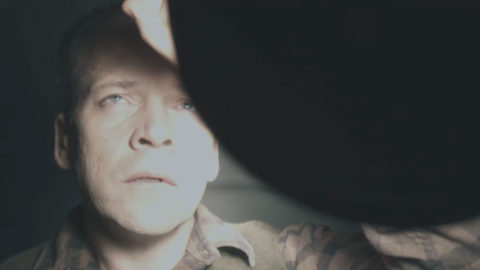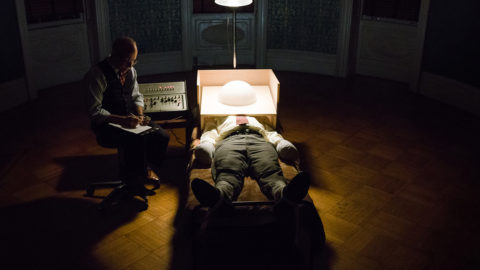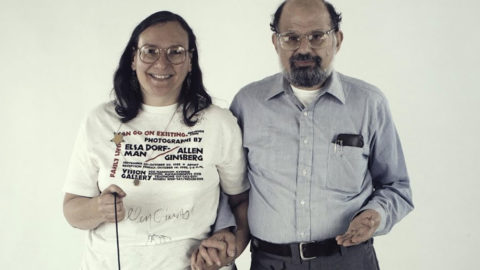Film of the Week: Wormwood
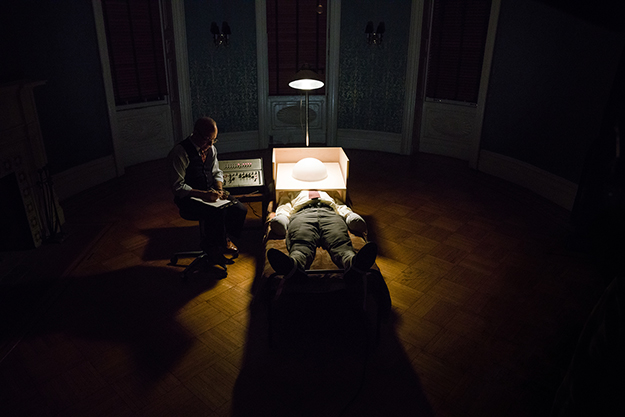
The meaning of the word “Wormwood,” in Errol Morris’s new film and TV mini-series of that name, functions not unlike “Rosebud.” It’s the thing—rather, one of the many things—that Morris keeps us wondering about through the course of his narrative, but which in itself proves ultimately unimportant, or at least, not the main mystery he’s concerned with. The word “Wormwood” is a piece of misdirection, in a film that’s very much concerned with the dark art of misdirection, but when the word finally recurs in a devastating sting of a payoff, we can see what Morris had in mind all along.
Now playing as a six-part series on Netflix, but also screening theatrically as a 258-minute movie, Wormwood is instantly recognizable as quintessentially Errol Morris, with its in-depth interviews and dramatized sequences echoing The Thin Blue. But it also takes him into uncharted new territory, not least in terms of length and complexity. Best described as a documentary investigation with acted reconstructions (or imaginings of at least hypothetical events), Wormwood is a labyrinthine delirium of a story in which the sought-for truth constantly seems to withdraw even as it unfolds, and that grows several new hydra heads every time one head seems satisfactorily lopped off, every time one investigative path seems exhausted.
The mystery behind Wormwood is the death, on November 28, 1953, of a bacteriologist named Frank Olson, who fell thirteen floors from the window of his room in the Hotel Statler in New York. The Olson family were told that Frank “fell or jumped”, but over the next few decades, the reality behind his death becomes the enduring obsession of his son Eric, 9 at the time of his bereavement. What really happened behind the door of room 1018A of the Statler is the primal scene to which Wormwood obsessively returns in its dramatized scenes, constructed with a positively Lynchian regard to eerie, dark-steeped atmosphere. At the start of the film, an anxious Frank Olson, played by Peter Sarsgaard, peers out of the spyhole in the door of 1018A, and sees variously himself, pacing nervously in the corridor outside, and himself again, this time waist deep in a lake. In this opening section, a nervous Olson sets the film’s apocalyptic tone by muttering a biblical passage from the book of Revelations, about the star named Wormwood that turned the waters bitter. The biblical stuff is doomy rhetorical dressing, but the stuff about poisoning and bitterness… you should hold onto that in the hours that follow.
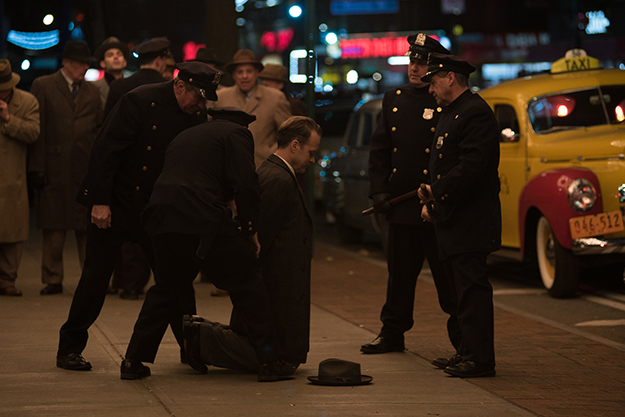
The more conventional documentary material in Wormwood is a set of interviews, conducted by a visible and sometimes audible Morris, with a series of participants in the Frank Olson story—mainly involved in a legal or investigatory capacity—and above all, with Eric Olson as he looks back over the tortuous ramifications of his lifelong attempt to solve the mystery of his father’s death. At times, Morris fragments the frame, so that multiple images of Olson, or other interviewees, shot from different angles, fill the frame. It’s an effect that some will reject as an irritatingly showmanlike mannerism, but there’s a logic to it: the film is all about complexity, multiplicity, simultaneity, the figurative problem of knowing which angle to see things from. Another technique used throughout also has a logical source in the material Morris is using: he often fills the screen with collaged images, scraps of what’s being discussed at any one moment, archive images, bits of superimposed captions and newsprint (the latter element familiar from his approach in the 2010 Joyce McKinney documentary Tabloid). The motivation for this approach is that Eric Olson wrote his doctoral thesis in clinical psychology at Harvard around the theme of collage as—if I’ve understood this right—a method of understanding and healing.
Morris himself pursues the collage technique to the extreme limits. A vast exercise in bricolage, Morris’s film omnivorously hoovers up and repurposes every bit of relevant (or sometimes tangential) material it can find: archive footage, TV interviews, related ephemera, visual footnotes of all kinds. Nothing is left un-illustrated: if someone happens to mention a film or a play, it finds its way into Wormwood, usually quite germanely. The fact that Frank, shortly before his death, saw Irving Pichel’s 1953 biopic Martin Luther means that Morris uses clips from the film, lending credibility to the figure of Frank Olson as a man standing alone before a condemning authority. There’s a passing reference to a line in Jacques Tourneur’s Out of the Past; we see Robert Mitchum saying, “All I can see is the frame. I’m going to see the picture.” Most telling all the way through is the use of clips from Laurence Olivier’s 1948 hyper-atmospheric Hamlet. Eric, a hugely literate, articulate and self-aware man, sees himself as a Hamlet figure, possessed by a need to solve the mystery of a dead father. His preoccupation with this mission messed up Eric’s own wedding plans, he says, like Hamlet’s match with Ophelia; it essentially “sucked him into the grave,” someone comments later, a notion that Morris illustrates succinctly with the shot of Hamlet’s shadow cast on a graveside, a skull lying exactly in the position of his own head.
The huge cast glimpsed in this encyclopedic production include Edward Kennedy, who chaired the 1977 Congressional hearing on the Olson case; President Gerald Ford, who invited the Olson family to the White House to offer an official apology (but never quite made it clear exactly what the U.S. government was apologizing for); various former CIA heads; a magician named John Mulholland, who wrote a manual of misdirection for the CIA; and Morris’s sparring partner in 2013’s The Unknown Known, Donald Rumsfeld, along with Dick Cheney. These last two are shady background figures but, it’s implied, may have their own counterparts in the two sinister men in hats who, it’s believed, knocked on the door of Room 1018A on the fateful night (oh yes, in this extravaganza of mirror play and multiples, doppelgängers play a part too).
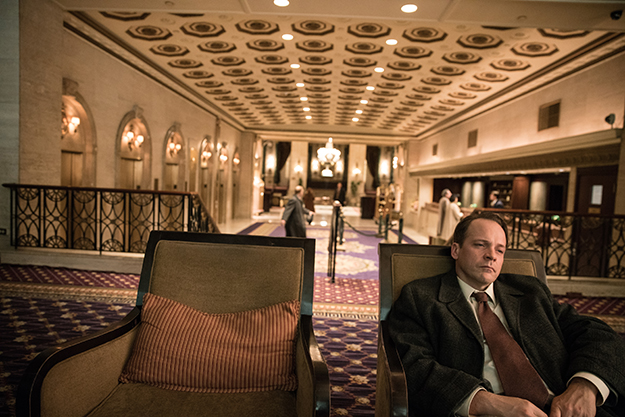
As for Morris’s interviewees, they include the various attorneys, advisors and acquaintances who played a part in unraveling the Olson mystery over decades. The most infuriating among them, and the one who most infuriates Eric Olson, is veteran investigative reporter Seymour Hersh, who played a key role in opening up the complexities of the case back in the 70s, then gave up on it, but came back into the picture years later, seeming to promise the ultimate unveiling that Eric dreamed of—and then backed away at the last minute. Interviewed by Morris, Hersh emerges as the one person in the film you’d like to slap—even if he is 80—simply because of his knowing smugness in presenting himself as the man who knows it all, but couldn’t possibly reveal it for fear of endangering someone’s life.
Hersh more or less ends up saying that the whole point of the story is that you can never get to the bottom of it. It’s something that, in his own way, Eric says too. In an eerie black-and-white image, the camera glides slowly down a long corridor, past a long succession of fortified doors: the image of the vault within a vault within a fault (a metaphorical place within which, somewhere, is supposedly stored an actual document explaining everything) is of Eric’s own coining. Acutely conscious of the existential depths of his lifelong dilemma, Eric is adept at philosophical thinking: in response to his mother’s statement that the family would never know what happened in Room 1018A, Eric proposes to reframe the question: “In what world did that room exist?” Later, he puts his whole inquiry into chilling perspective when he says that, if consulted by truth-seekers in a similar situation to his own, he would advise them, “stipulate the worst, then worse still—then let it go.” His whole story, he says, is a cautionary tale.
Eric’s lucidity—his analytical brilliance and his awareness of the damage he has incurred, partly as a result of his own tenacity—makes him a superb interviewee and an incisive commentator on his own statements. His self-awareness generates a kind of feedback loop in the film, as if Eric were his own double, his older, wiser, wearier self commenting on the investigative passion (or folly) of the younger Eric.
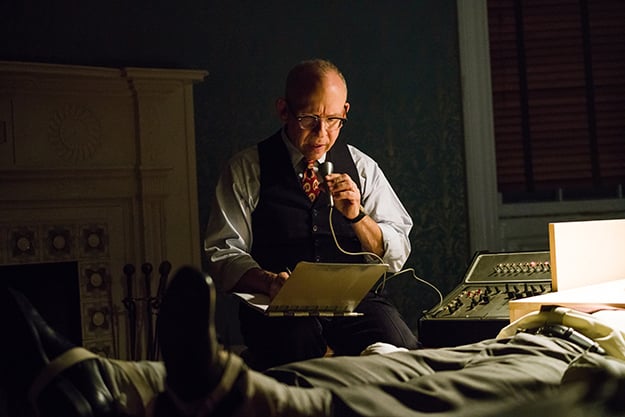
This kind of splitting, or fragmenting, works its way throughout Wormwood, in visual metaphors such as the shower of glass fragments exploding in slow motion as Frank Olson crashes through the hotel window, just as the discernible truth of his death has shattered into jigsaw shards. Meanwhile, some sort of comprehensible reality is discernible in the dramatized scenes from the last days of Olson’s life—but much of that content is to be taken with a pinch of salt. What really happened in a log cabin at Deep Creek Lake where LSD was apparently slipped into Olson’s cocktail? What happened at his meetings with New York allergist Harold Abramson (played to immensely sinister effect by Bob Balaban)? Was a troubled Olson really found leaning upside down against a wall to the accompaniment of “Hound Dog”? Everything is speculative here—hence plural differing re-enactments of Olson’s death at the end of the film. But that claustrophobic room returns over and over as the continuous dark thread in the fabric—as does Sarsgaard’s performance as Frank Olson, his sotto voce nervousness (somewhat this actor’s specialty) conveying the fine sense of a delicate man whose own fabric is gradually unraveling.
How much truth do we finally glean from Wormwood? It’s a moot point. Eric’s final despairing comments suggest that you can only get to so much of the truth anyway, and that trying to unearth it is ultimately a fool’s errand. This won’t be the first time that an Errol Morris film has raised troublesome questions about the capacity of documentary—and of Morris’s documentaries specifically—to establish truth. With its encyclopedic sprawl and meticulous construction of a meta-spider-web pattern of fact (the tour de force editing is by Stephen Hathaway), Wormwood is a consummately involving piece of true-crime entertainment. But it’s a dilemma of a film. On one hand, it dismantles the idea of conspiracy theory in that it’s saying that yes, of course, the CIA indulges in nefarious practices, and there’s nothing mystificatory or outlandish about that. On the other hand, its vertiginous recreation of the patterns of an eternally baffled, and self-baffling paranoid mindset feels as obfuscatory as it does revealing. No doubt that’s Morris’s point—that no enlightenment is possible unless you’re willing to wade, like Eric Olson, through the fog of unknowing. You may emerge with your head spinning at the end of Wormwood, but you’ll be sure of one thing—this mystery is considerably more complex than the Rosebud riddle, and in its effect on Eric Olson’s life, considerably more tragic.
Jonathan Romney is a contributing editor to Film Comment and writes its Film of the Week column. He is a member of the London Film Critics Circle.



